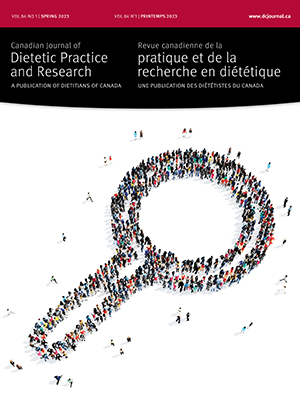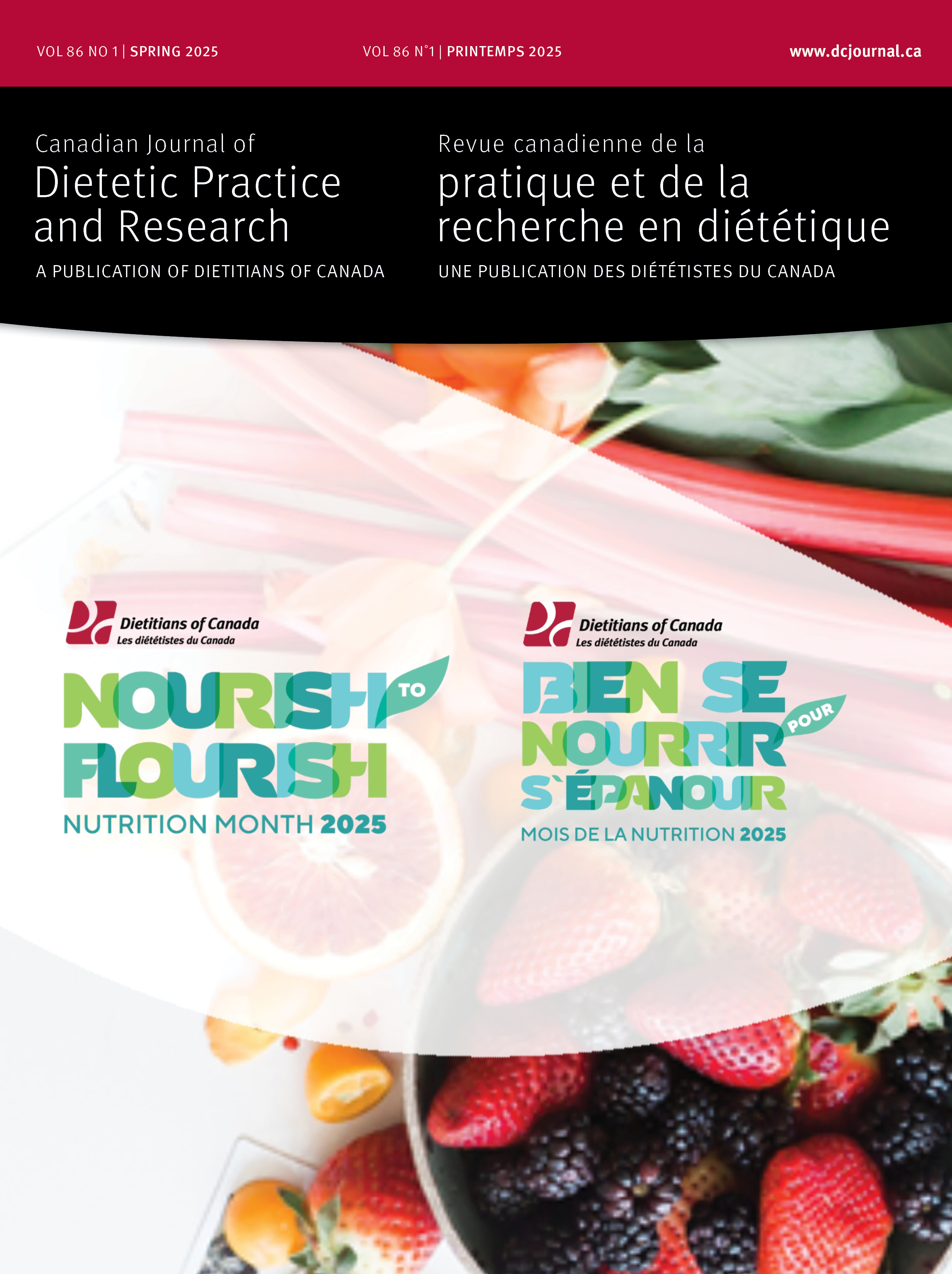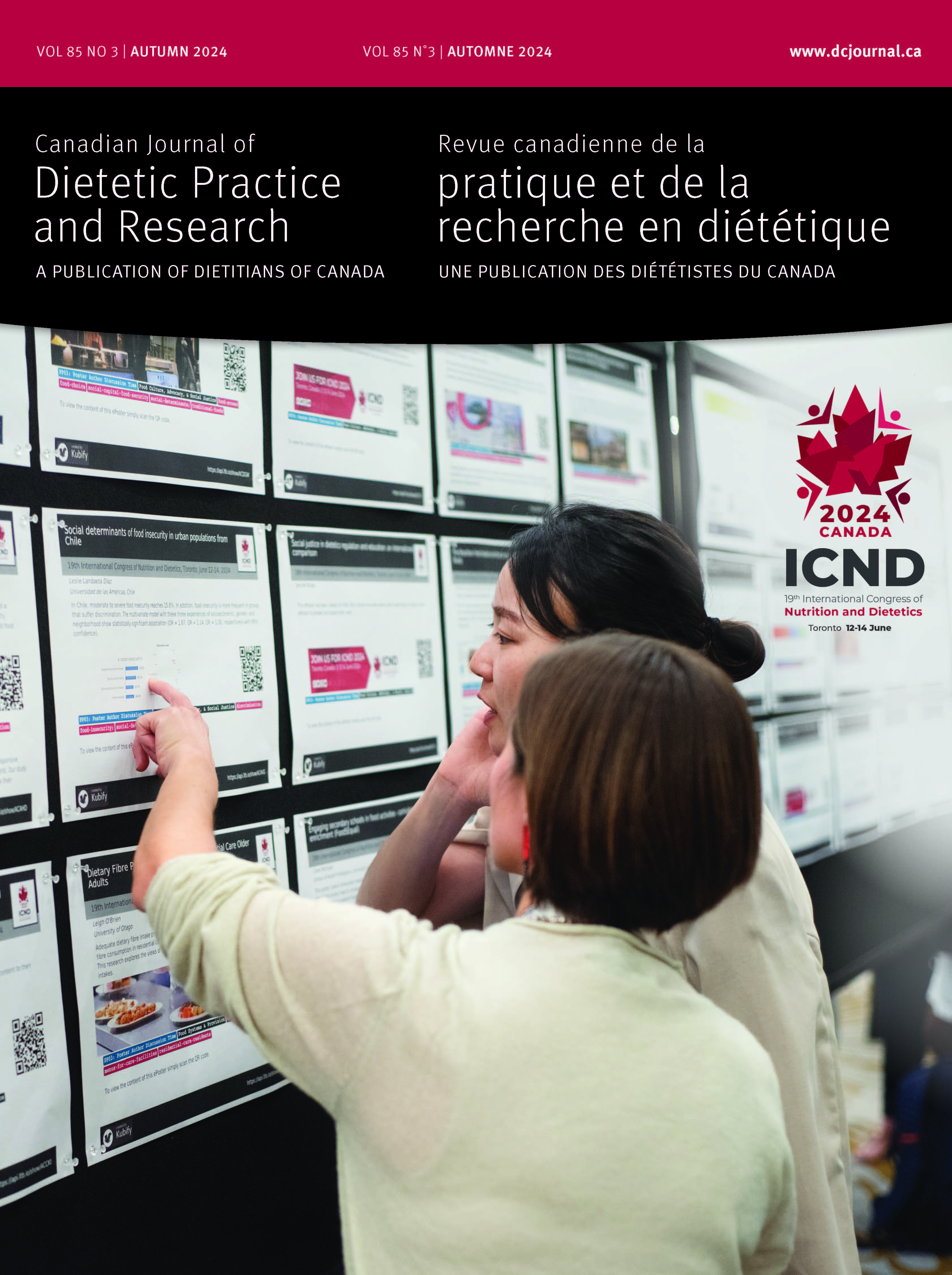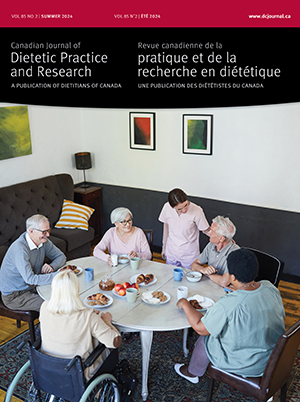Volume 84 • Number 1 • March 2023
Editor’s Message
Research
Purpose: Barriers in research for women and dietitians have been documented. We sought to describe tri-council funding awarded within the nutrition discipline according to institution type, academic rank, gender, dietitian status, and primary research methods used.Methods: Using an online search methodology, faculty members with research appointments were identified from nutrition departments offering accredited dietetic programs and/or at Canada’s collective of research-intensive universities known as U15. All data regarding faculty members, their institutions, and funding were collected through publicly available websites and Scopus. Tri-council funding associated with the nominated principal investigator, from a 5-year period, 2013–2014 to 2017–2018, was extracted. Binary logistic regression was used to test for predictors of receiving any tri-council operating funds within the 5-year period.Results: Faculty members (n = 237) from 21 institutions were identified for inclusion. Those from U15 institutions, at the full professor rank, nondietitians, men, and those who engaged in primarily quantitative research methods (vs. qualitative or mixed-methods) were significantly more likely to hold any tri-council funding during the eligible period. Dietitians (n = 76) were significantly less likely to hold tri-council funding, independent of institution, rank, gender, and primary research methods utilized.Conclusions: The apparent under-funding of academic dietitians from federal tri-council sources requires exploration.
Purpose: COVID-19 has disrupted the daily routines of many Canadian families. In Ontario, provincially mandated public health measures have resulted in significant changes to school policies, including those related to food. The impact of COVID-19 related school food policies on parental lunch packing habits is unknown; therefore, this study investigated how school-related COVID-19 policies have impacted parental school lunch packing habits.Methods: Parents (N = 287) of school-aged children were recruited from parent-specific Facebook groups across Ontario, Canada, to complete an online survey regarding lunch packing habits. This survey was developed based on findings from a previously conducted scoping review. Open-ended survey responses were inductively analyzed.Results: Three over-arching themes were constructed: (1) Food Programs and COVID-19; (2) Schedule Changes; and (3) School Policy Changes. Parents explained that the cancellation or modification of food programs at schools, changes to the length of time children are given to eat at school, and removal of access to microwaves, garbage cans, and teacher assistance during lunch have forced parents to change their lunch packing habits.Conclusion: Findings from this study demonstrate a need for better support to help ease the burden parents experience when packing their child’s school lunch, during an already extremely stressful time.
Purpose: Describe food/beverage intake among all patients and those with low meal intake and determine if the Hospital Food Experience Questionnaire (HFEQ), or its shorter version (HFEQ-sv), predicts food intake while considering patient (e.g., gender) and hospital characteristics (e.g., foodservice model).Methods: Cross-sectional study of 1087 adult patients from 16 hospitals in Ontario, Canada. The valid and reliable HFEQ assessed patients’ meal quality perceptions. Visual estimation determined overall meal and food/beverage intake using the Comstock method. Binary logistic regressions tested the association between patient and hospital characteristics and whether HFEQ or HFEQ-sv scores added utility in predicting overall meal intake (≤50% vs. ≥75%).Results: Approximately 29% of patients consumed ≤50% of their meal. Models assessing patient and hospital characteristics and either the HFEQ or the HFEQ-sv were significant (LRT(43) = 72.25, P = 0.003; LRT(43) = 93.46, P < 0.001). Men and higher HFEQ or HFEQ-sv scores demonstrated significantly higher odds of ≥75% meal consumption. Considering HFEQ or HFEQ-sv scores explained greater variance in meal intake and resulted in better model fits.Conclusions: The HFEQ and HFEQ-sv predict patient meal intake when adjusting for covariates and add utility in understanding meal intake. Either version can be confidently used to support menu planning and food delivery to promote food intake.
Perspectives in practice
The objective of this evaluation was to determine Northern Ontario School of Medicine (NOSM) undergraduate medical education (UME) students’ perceptions of the curriculum related to their nutrition knowledge, attitudes, and counseling self-efficacy/confidence. A 16-item electronic survey (Qualtrics©) was developed, and it included nutrition competency statements, adult and pediatric nutrition assessment and counseling confidence, and nutrition curriculum satisfaction. Students in Years 2, 3, and 4 (n = 192, 66%–73% female) were invited to answer the survey. Of the 61 respondents, 50.8% were Year 2, 34.9% Year 3, and 10.6% Year 4. Overall, 72.1% of the respondents were dissatisfied. Respondents perceived they were least competent in strategies to prevent and treat disease (72.1%), in applying basic dietary strategies (65.6%), and in ethics and nutrition management (62.3%), whereas 52.5% felt competent in the team approach to nutrition care. Respondents reported lowest confidence (less than 10%–15%) in specialized nutrition support, cancer care, renal nutrition, and mental health/eating disorders for both populations. NOSM medical learners reported curriculum dissatisfaction, nutrition incompetence, and poor levels of perceived confidence in nutrition management. Results will be used to inform nutrition curriculum enhancements and future outcome evaluations. Current and future physicians with enhanced nutrition knowledge, awareness of the Registered Dietitian (RD) roles, and an understanding of when to refer patients to an RD can provide better patient-centred care.
Continuing care (CC) facilities have been impacted by a growing demand for services, insufficient resources for the provision of quality food and nutrition care, and, most recently, the COVID-19 pandemic. This study explored the roles and responsibilities of dietitians working in CC facilities in Nova Scotia (NS) before and after the COVID-19 first wave. Using ethics-approved questionnaires, the estimated 75 dietitians working in CC facilities in NS were surveyed in Fall 2019 and Fall 2020 about their roles and responsibilities. Twenty responded to the first questionnaire and 15 to the second. Analysis of data included simple statistical and qualitative description methods. The findings highlighted the complexities and challenges faced by these dietitians in the provision of resident nutrition care, overseeing foodservices, training staff and dietetic interns, and contributing to facility specific care committees before and after the COVID-19 first wave. There is a need to advocate for minimum standards for dietetic and foodservice funding in CC facilities based on higher acuity and complex care needs of residents and considering the multifaceted roles of dietitians in CC. Efforts to improve awareness about the roles of dietitians working in CC among resident families, other dietitians, and dietetic interns are also needed.
Ultra-processed foods (UPFs) have become a major contributor to the diets of Canadians, with a recent report from Statistics Canada suggesting Canadians are consuming almost one-half of their calories from UPFs. Research has linked UPF consumption with increased risk for chronic diseases such as cardiovascular disease and type 2 diabetes, among others. This paper sought to investigate the popularity of UPFs, particularly among children and teens, utilizing the socioecological model as a framework to illustrate how influences at multiple levels (i.e., public policy, organizational, community, interpersonal, and individual) have played a role in the proliferation of UPFs. Evidence from previous studies is used to identify how factors at different levels may influence UPF consumption and discuss potential strategies for reducing UPF consumption. To meaningfully reduce UPF consumption among Canadians, all levels should be considered, with the goal of creating a healthier Canadian population.
Weight bias and discrimination are highly pervasive and harmful to Canadians with higher weights. Researchers and practitioners who deliver, evaluate, and advise on dietary and weight-related interventions may inadvertently perpetuate weight bias through their work; however, trainees in these fields rarely have access to weight bias education within their applied health programs. This study evaluated the acceptability of an online educational weight bias module developed for undergraduate students enrolled in health courses. The intervention included a pre-recorded 20-minute online module with prompts for reflection or discussion, a self-assessment quiz, as well as a separate module and range of resources for instructors. Overall, 211 students from applied health courses and 4 instructors completed an online survey querying the module’s delivery, impact, and relevance. Students agreed that the module provided useful information (82%), was easy to understand (97%), and was the right length (75%), but reported wanting more interactivity and engagement with the content. Instructors found the module engaging and useful and expressed interest in additional resources and support for weight bias education. Future research should explore the impact of weight bias education on students’ weight-related attitudes and perceptions as well as feasibility and relevance of online features such as multimedia tools.
Report
Purpose: Canada’s Food Guide (CFG) contains recommendations for healthy eating for Canadians. The objective was to examine the awareness of and learning about CFG by Canadian youth.Methods: Cross-sectional online surveys were conducted with 3,674 youth aged 10–17 years in Canada in November/December 2019. Logistic binary regression models examined awareness of CFG, learning about CFG in school, and learning about healthy eating in schools in the past 12 months.Results: Most participants reported hearing of CFG (84.5%), learning about CFG in school (86.6%), and learning about healthy eating in school (65.4%) in the past 12 months. Awareness of CFG was higher among females (OR: 1.61; 95% CI: 1.32–1.96), older youth (1.70; 1.39–2.07), and those in Atlantic Canada (OR: 1.77; 95% CI: 1.10, 2.84). Significantly fewer East/Southeast Asian, South Asian, Latino, and Middle Eastern participants reported hearing of CFG compared to white participants (p < 0.05 for all). Unstated/missing BMI (0.56; 0.45–0.71) and living in BC (OR: 0.61; 95% CI: 0.45, 0.82) were negatively associated with hearing about CFG. Similar results were observed in the models on learning about CFG and healthy eating in school.Conclusions: This study indicates discrepancies in awareness of CFG among youth by sex, ethnicity, region, and BMI which may suggest differences in use of CFG and healthy eating behaviours.
Objectif. Documenter la perception des soldats des Forces armées canadiennes (FAC) quant aux facteurs influençant leur apport alimentaire en rations de combat durant leur travail en Arctique.Méthodes. Un questionnaire bilingue électronique a été envoyé nationalement à des soldats s’étant entraînés dans l’Arctique entre 2015 et 2018. Il comportait 6 questions ouvertes et 33 fermées sur les facteurs influençant l’apport alimentaire et l’acceptabilité des rations.Résultats. Parmi les 54 questionnaires remplis (taux de réponse : 31 %), 6 étaient incomplets et ont été exclus. L’échantillon final était composé de 48 militaires de neuf provinces ayant en moyenne 12,1 ± 6,8 années d’expérience dans les FAC. Les facteurs ayant le plus d’effets négatifs sur l’apport alimentaire étaient la température des aliments, le fait de manger en se déplaçant, l’horaire des exercices et activités, ainsi que l’équipement nécessaire à la préparation et à la consommation. Les participants ont déclaré avoir consommé entre 61 et 71 % des rations. Ils ont noté qu’un temps considérable était nécessaire pour préparer les rations puisqu’elles étaient congelées. Soixante-cinq pour cent des soldats ont rapporté une perte de poids durant leur travail dans l’Arctique.Conclusions. Une multitude de facteurs a influencé l’apport et les pratiques alimentaires des soldats. Ces résultats guideront les recherches futures et aideront à la prise de décisions concernant de possibles changements aux rations en Arctique.
Purpose: To investigate the breakfast quality of preschool-aged children through a comparison of their energy and nutrient intakes at breakfast to published benchmarks for a balanced breakfast.Methods: Dietary data were collected for 163 children aged 3–5 years enrolled in the Guelph Family Health Study using one parent-reported online 24-hour recall and analyzed for energy and nutrient intakes. Breakfast quality was assessed by tallying the frequency of participants whose nutrient and energy intakes at their breakfast meal met the recommendations for a balanced breakfast established by the International Breakfast Research Initiative (IRBI).Results: Almost all participants (98%) consumed breakfast, and most participants (82.5%) met the energy IRBI recommendation. However, the majority of participants did not meet the IRBI recommendations for breakfast intakes of most macronutrients and micronutrients. In particular, fewer than 25% of participants met the IRBI recommendations for breakfast intakes of dietary fibre, niacin, folate, vitamin C, calcium, potassium and zinc.Conclusions: Almost all preschool-aged children in this study consumed breakfast, but the nutritional quality of their breakfast did not meet recommendations for most nutrients. These results can inform nutrition education and intervention programs for children that aim to improve the nutritional quality of breakfast.










